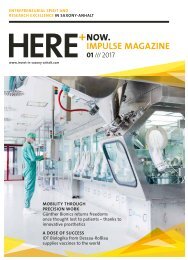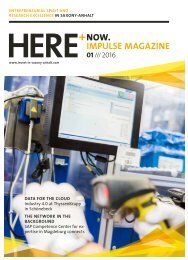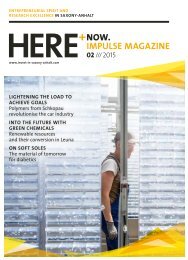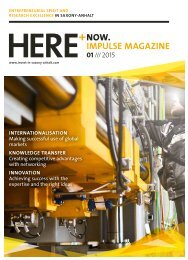HERE+NOW. Impulse Magazine // Future Technologies 2020
The German economy is undergoing a period of upheaval. The automotive industry is investing billions in developing new powertrain technologies and mobility services, while manufacturing industries and mechanical engineering are becoming greener and more sustainable. Following the phase-out of nuclear power, by 2038 brown coal will no longer be used for electricity generation and priority is being given to developing renewable energy sources. And importantly, digitalization is making its way into almost all areas of our lives. And as if all of this weren’t exciting enough, 2020 will go down in history as the year of the coronavirus pandemic. The virus is not only putting businesses and jobs at risk, it is also speeding up some development processes.
The German economy is undergoing a period of upheaval. The automotive industry is
investing billions in developing new powertrain technologies and mobility services, while
manufacturing industries and mechanical engineering are becoming greener and more
sustainable. Following the phase-out of nuclear power, by 2038 brown coal will no longer be used
for electricity generation and priority is being given to developing renewable energy sources.
And importantly, digitalization is making its way into almost all areas of our lives. And as if all of this weren’t exciting enough, 2020 will go down in history as the year of the coronavirus pandemic. The virus is not only putting businesses and jobs at risk, it is also speeding up some development processes.
Create successful ePaper yourself
Turn your PDF publications into a flip-book with our unique Google optimized e-Paper software.
NEW MOBILITY IN SAXONY-ANHALT
The energy needed to test components is provided
almost entirely by electricity generated
from renewable resources. This comes from
12,000 square meters of photovoltaic panels
which cover the entire roof of the building and
have an output of over 900 kWp. “The new
facility is climate-friendly and operates on
the basis of a zero CO 2
emissions approach,”
explains Pischinger.
Testing to the limit
Zero-Co 2
: 12,000
square meters of
photovoltaic panels
provide energy.
The foundations for the success of FEV were
laid in Saxony-Anhalt in 2007. The FEV Group
has another site in Sandersdorf-Brehna where
powertrains of all kinds are subjected to
endurance tests. The new test center reflects
the significant increase in electric mobility.
FEV employs around 6,700 people on five
continents worldwide and 350 of them work
in Saxony-Anhalt. Over recent years, Saxony-
Anhalt’s Ministry of Economy has supported
FEV’s investment with a total of 15 million euros
from the Joint Task for the Improvement of
Regional Economic Structures (GRW).
FEV has the world’s largest development and
test center for high-voltage batteries. The
electricity that powers the center comes almost
exclusively from its own photovoltaic system.
FEV, a leading international provider of
design and development services for hardware
and software for vehicles and powertrains,
has brought into operation the world’s largest
development and testing center for high-voltage
batteries at its site in Sandersdorf-Brehna
in the triangle between Halle (Saale), Dessau
and Leipzig. The new center has 54 climatic
and temperature chambers, eight chambers
for environmental testing, a shaker system
for mechanical tests, which is the only one of
its kind in the world, and five chambers for
abuse tests. It will be testing batteries for cars
and trucks from almost all the world’s vehicle
manufacturers.
The test facilities allow all the factors that
influence battery behavior to be simulated.
These include driving conditions on roads
ranging from freeways to dirt tracks, flooding
and extremely cold and hot weather.
In addition, FEV exposes the batteries to fires
and impacts in order to obtain important
information about how high-voltage batteries
behave in the event of an accident. The center
will also run endurance tests covering up to
250,000 kilometers. In addition, it has a workshop
where the batteries can be disassembled
after testing. The new development and test
center is the largest of its kind in the world.
“As one of the world’s leading
developers of technologies
for electric vehicles, FEV produces
innovative, future-proof
solutions. The new test center
allows us to demonstrate our
expertise to our customers yet
again. In addition to providing
our partners with the best
possible technical support, we
can also save them development
time and costs,”
says Professor Stefan Pischinger, President
and CEO of the FEV Group. He adds: “We currently
have a total of 69 test systems, which
means that we can provide all the internationally
established test methods for batteries
under one roof.”
fev.com
edlp.fev.com
Testing to the
limit: FEV tests
batteries in
climate and
temperature
chambers.
18
19

















